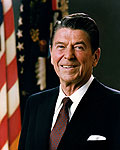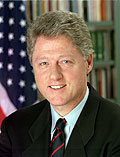1980: Electronic Age for Treasury Securities

Official Portrait of
President Ronald Reagan,
1981
"For decades, we have piled deficit upon deficit, mortgaging our future and our children's future for the temporary convenience of the present.... You and I, as individuals, can, by borrowing, live beyond our means, but for only a limited period of time. Why, then, should we think that collectively, as a nation, we are not bound by that same limitation?"
Ronald Reagan, 1981, Inaugural address
Ronald Reagan (b, February 6, 1911 - d, June 5, 2004), who became the 40th president of the United States in 1980, declared "debt" to be one of his major campaign issues.
Reagan and his advisors were adherents of Milton Friedman (b. July 31, 1912 - d. November 16, 2006), an American Nobel Laureate economist, a promoter of "economic liberalism," and an intellectual renowned for his theories of "consumption analysis." Friedman advocated minimizing the role of government in a free market as a means of creating political and social freedom. This "laissez-faire" style of economics allowed "the market" to set prices and interest rates.

Series HH Bond, 1980
Between 1980 and 1990, the debt more than tripled as the government borrowed money to fund military build-ups and many elaborate new policies, such as "the war on drugs." Americans began relying more and more on credit cards and jumbo mortgages, and being "in debt" became a new way of life in America.
And yet, as the Cold War drew to a close, the economy of the United States remained essentially healthy. How could this be? It is said that the Cold War was fought not by armies, but by banks. From the 1950s through the 1980s, both sides built massive debt during their international shadow-boxing match. Western powers "won" this match not by the size of their debt, but by the nature of that debt, according to a 1995 article in USA Today. "The U.S. financed its battles in the Cold War by borrowing against the future, constraining, but not really limiting, social spending," the article posits. "The Eastern bloc financed its Cold War battles the only way it could: by taking shortcuts on every imaginable count, saving a ruble here... and a ruble there." Thus, when the Berlin Wall came down in 1989, the U.S., guided by policy carried out by the Treasury, was better able to take advantage of economic growth to come.
In 1983, the first "personal computers" arrived at Public Debt, in the Division of Administration, supported (in 1986) by a new IBM mainframe computer system. The new "computer age" brought major changes to the staffing of the Bureau (sometimes resulting in reductions) and to the processing of bonds and other instruments (facilitated by new technologies like optical and magnetic character recognition and advanced scanning).
In 1986, Public Debt introduced Legacy Treasury Direct, a system allowing investors to buy Treasury securities in book-entry form and hold them directly with Treasury, electronically, without the services of a broker or other intermediary.
1990: Public Debt Goes Online

Official White House photo
of President Bill Clinton,
1993
Despite backlashes against '80s "greed," and the obstacle of the huge public debt (approximately $3.3 trillion in 1990), the economy of the United States was relatively strong at the start of the new decade. The government made a commitment to "fiscal discipline," and in 1998, President Bill Clinton (b, August 19, 1946) presented to Congress the first balanced federal budget (with no annual deficit) since 1969.
Throughout the '90s, a Wall Street boom drove investment in Treasury securities. Treasury kept up with demand by taking advantage of many technological breakthroughs.
In 1992, Bureau computer systems are again upgraded when the IBM mainframe is replaced with an Amdahl system. It's about this time that (no reflection on the new systems) the first "computer virus" strikes at Public Debt. (It is cured quickly!)
By the mid-'90s, Public Debt was online! The first Bureau of the Public Debt website was on America Online. Soon, users could access Public Debt through a Treasury-managed website, and then, in December, 1997, through Public Debt's own website based in Parkersburg (publicdebt.treas.gov). A new Y2K compliant IBM 9672-R35 CMOS computer replaced the Amdahl mainframe, and new technology finally allowed the mainframe and client/server technology to merge, helping the Bureau itself become more "user friendly."
2000: A New World

Series I Bond
While the new millennium began quite auspiciously, terrorist attacks in New York, Pennsylvania and Washington DC on September 11, 2001, seriously undercut the economic progress being made in the United States. To counter the effects of the economic slowdown and the increased expenditures on national security that followed the attacks, the new president, George W. Bush (b, July 6, 1946), instituted tax cuts and refunds, but the deficit grew, and with it, the national debt.
Meanwhile, Public Debt set about to aggressively take advantage of new technologies for success. The IBM CMOS was replaced with the new, more powerful IBM Z900. Then, in October of 2002, the first version of TreasuryDirect is opened to the public, offering the ability to purchase and manage holdings of Series I savings bonds through a single online portal (www.treasurydirect.gov). Throughout the 2000s, Treasury instituted many more state-of-the-art initiatives for the benefit of investors, including OTC Direct, a web-based system for purchasing paper savings bonds, and FedInvest, an online administration tool for Federal agencies to use when investing in Treasury securities.
Today
Today, Treasury's Fiscal Service, with the assistance of the Bureau of the Public Debt, continues to help guide, administer and manage US government financial policy for the best possible returns.
Through our massive online resources and state-of-the-art investment and administrative tools, federal agencies and individual investors alike have more access to the world of government finance than ever before.
Public Debt employs nearly 2,000 dedicated, highly-trained people in multiple locations. The success of the bureau today, and of all of its associated agencies and services, is due directly to the commitment, knowledge and enthusiasm of the people who keep the Bureau of the Public Debt running smoothly.
- Wholesale Securities Services
- 220 auctions annually
- $9.1 trillion in bids
- $4.5 trillion awarded
- $4.2 trillion in marketable securities held in National Book-Entry System
- 1.3 trillion in Treasury securities transfers daily
- Retail Securities Services
- $195 billion in paper savings bonds held by 55 million investors
- $72.7 billion in book-entry marketable issues held in Legacy Treasury Direct by 383,000 investors
- $9.2 billion in electronic savings and marketable issues held in TreasuryDirect by 285,000 account holders
- Government Agency Investment Services
- $3.9 trillion invested by 80 federal agencies
- $301 billion invested by 7,000 state and local governments
- $234 billion loaned to 39 federal agencies
- Summary Debt Accounting
- $8.8 trillion outstanding
- $4.9 trillion held by the public
- $3.9 trillion held by government accounts
- $72 trillion flow of funds annually
- Franchise Services
- 72 agency customers
- $80 million (est.) in annual revenue



